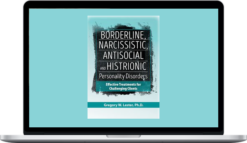NICABM – How To Work With Emerging Defense Responses To Trauma (Beyond The Fight/Flight/Freeze Model)
$197.00 $89.00
»Delivery: Within 21 days
Description
NICABM – How To Work With Emerging Defense Responses To Trauma (Beyond The Fight/Flight/Freeze Model)
Description Of How To Work With Emerging Defense Responses To Trauma
How to Identify and Address the Survival Responses That Perpetuate Suffering and Block Therapy
Develop a more targeted and nuanced approach to treating trauma.
For years, clients have presented with defensive adaptations to trauma that don’t fit within the fight-flight-freeze model you learned in grad school.
And without the tools to identify and address these (often subtle) adaptations, many clients were left stuck, stagnant, and suffering.
But recently, the top minds in our field have developed strategies to help us take a more targeted and nuanced approach with these “emerging” trauma responses . . .
. . . and become more effective in our ability to help clients overcome unresolved trauma.
That’s why we asked a few of those top minds to share how they identify and work with trauma responses that fall outside the fight-flight-freeze model.
What You’ll Learn In How To Work With Emerging Defense Responses To Trauma
How to Work with Emerging Defense Responses to Trauma (Beyond the Fight/Flight/Freeze Model)
Attach/Cry-for-Help: Perhaps the Least Understood Defense Response
Janina Fisher, PhD Stephen Porges, PhD
Pat Ogden, PhD Deb Dana, LCSW Kathy Steele, MN, CS
- Specific Behavioral Patterns That Can Help You Recognize a Client’s Attach/Cry Response
- Why This Response Often Produces the Opposite of What a Client Wants (and How That Can Complicate Treatment)
- How to Work with Attach/Cry Through a Polyvagal Lens
- One Disorder That Is Commonly Misdiagnosed in Clients Who Enact Attach/Cry (and How to Differentiate Between the Two)
- How a Clinician’s Natural Instincts Can Backfire When Working with Attach/Cry (and What Approach to Take Instead)
- Strategies to Establish Effective Boundaries with Clients Who Enact Attach/Cry
- How to Keep Clients (and Yourself) Regulated When Working with Attach/Cry
- Two Common Challenges of Working with Attach/Cry (and How to Overcome Them)
Collapse/Submit: The Defense Response of Last Resort
Ruth Lanius, MD, PhD Deb Dana, LCSW Pat Ogden, PhD
- Four Specific Ways Collapse/Submit Can Present in a Client (and One Common Disorder That Can Mask Its Presence)
- Strategies to Stay Grounded and Clinically Effective When Working with a Client in Collapse/Submit
- Why a Habitual Collapse/Submit Response Can Leave Clients Vulnerable to More Trauma
- The Neurochemical Reactions That Activate a Client’s Collapse/Submit Response
- How to Engage a Client’s Sympathetic Nervous System Without Pushing Them into a Fight/Flight Response
- One Way to Bring Your Client Out of Collapse/Submit During a Session
Please and Appease (the Fawn Response): The Defense Response of Self-Erasure
Thema Bryant, PhD Usha Tummala-Narra, PhD Deb Dana, LCSW
- Strategies to Recognize and Attune to a Client’s Please and Appease Response
- How a Client’s Please and Appease Response Can Derail Therapy (and Specific Precautions to Take When Working with It)
- Cultural Factors to Consider When Working with a Clients’ Please and Appease Response
- How Please and Appease Can Force Clients to Neglect Their Own Needs (and Strategies to Help Them Become More Assertive)
- Key Questions to Help Clients Understand the Origin of Their Please and Appease Response
- How to Work with Please and Appease at the Level of the Nervous System
About NICABM
We proudly provide continuing education for practitioners who are dedicated to being the best in their craft. Our goal is to develop programs that connect you with the top experts and the latest strategies in the field, to help you achieve better outcomes, more quickly with each of your clients.
More courses from the same author: NICABM
Delivery Policy
When will I receive my course?
You will receive a link to download your course immediately or within 1 to 21 days. It depends on the product you buy, so please read the short description of the product carefully before making a purchase.
How is my course delivered?
We share courses through Google Drive, so once your order is complete, you'll receive an invitation to view the course in your email.
To avoid any delay in delivery, please provide a Google mail and enter your email address correctly in the Checkout Page.
In case you submit a wrong email address, please contact us to resend the course to the correct email.
How do I check status of my order?
Please log in to HealingCourse account then go to Order Page. You will find all your orders includes number, date, status and total price.
If the status is Processing: Your course is being uploaded. Please be patient and wait for us to complete your order. If your order has multiple courses and one of them has not been updated with the download link, the status of the order is also Processing.
If the status is Completed: Your course is ready for immediate download. Click "VIEW" to view details and download the course.
Where can I find my course?
Once your order is complete, a link to download the course will automatically be sent to your email.
You can also get the download link by logging into your HealingCourse account then going to Downloads Page.
Related products
Total sold: 1
Total sold: 4
Total sold: 8
Total sold: 1










